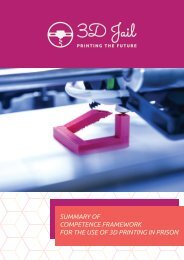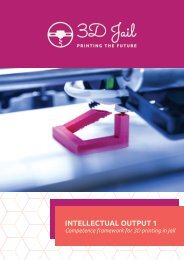Training models for the use of 3D printing technology in prison
3D Jail project further involves a training program for the training and development of trainers who are going to deliver the training program for inmates. Trainers are required to have basic computer, CAM and CAD skills. For the training of the trainers has also been planned an in-service training program to cover information on general characteristics of penitentiary institutions and inmates, use of the e-learning portal, and 3D printing.
3D Jail project further involves a training program for the training and development of trainers who
are going to deliver the training program for inmates. Trainers are required to have basic computer,
CAM and CAD skills. For the training of the trainers has also been planned an in-service training
program to cover information on general characteristics of penitentiary institutions and inmates, use
of the e-learning portal, and 3D printing.
Create successful ePaper yourself
Turn your PDF publications into a flip-book with our unique Google optimized e-Paper software.
New Zealand’s E-Learning Solution
In 2012, the New Zealand Department of Corrections undertook a pilot program to explore the effects
of e-learning on improving educational outcomes for confined youths. Key features of this program
include the following:
●
●
●
●
●
●
Purpose: E-learning is designed to support broader strategies for creating lasting educational
and employment change, better public value, better outcomes for confined youths, better
community outcomes, and reduced recidivism.
Content: The e-learning solution transitions delivery of literacy and numeracy assessments
from the traditional pen-and-paper method to a secure, point-to- point Web-based platform.
Additionally, the e-learning solution provides access to educational and vocational skillbuilding
resources and programs using the secure delivery system. Students also can access
the e-learning solution to take part in education and job training programs that were
previously unavailable to them. The online e-learning pilot classes primarily focused on basic
education skill-building and digital literacy training.
Eligibility: E-learning was piloted by 48 incarcerated students meeting specific mitigating
criteria to lessen the risk of security breaches. Participating students took preliminary online
diagnostic reading and numeracy assessments and were assigned remedial coursework on the
e-learning platform.
Security: Student access was stringently managed throughout the pilot, as were all other
access points to the e-learning system — from physical escorts, pat downs, and security
wandings prior to classroom entry to tutor-led sign-on protocols.
Students with information security–related convictions were not allowed to participate in the
pilot.
Availability: Approval for a stage-one roll-out was granted on July 31, 2014. This will involve
implementing 13 online e-learning computer suites at 10 prison sites through 2015. It also will
include literacy and numeracy training and assessments, core educational programming,
digital literacy, and job training and job search skills.
United Kingdom’s Virtual Campus
The Virtual Campus (VC) was developed by the U.K.’s prison service manager Mark Taylor in 2007,
with funding from several government ministers and design support from several software and
hardware companies (i.e., CISCO, XA Solutions, and others). It was subsequently given ministerial signoff
in 2010 and was deployed across England and Wales. Key features include the following:
●
●
●
●
●
●
Purpose: The VC is designed to enhance classroom educational opportunities, diversify and
individualize student learning, increase job readiness and job placement, and engage hard-toreach
students struggling in traditional classroom settings.
Content: In dedicated classrooms, students can access their current courses, other secondary
and postsecondary e-learning courses, and a resume-builder program.
Security: Students using the VC are continuously monitored by trained staff or a trained VC
education instructor.
Messaging: A secure relay messaging system allows students to send a message with a resume
or other certificate to an appropriate advisor within the facility.
Internet access: An applications programming interface provides students with access to sites
for job searching, such as Monster.com.
Availability: The VC is currently available to more than 25,000 incarcerated students in the
3DJail printing the future – IO2
9





